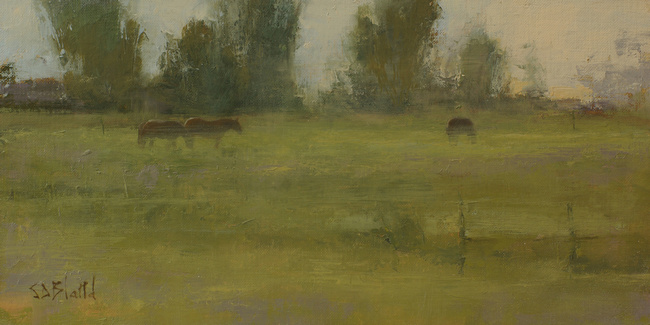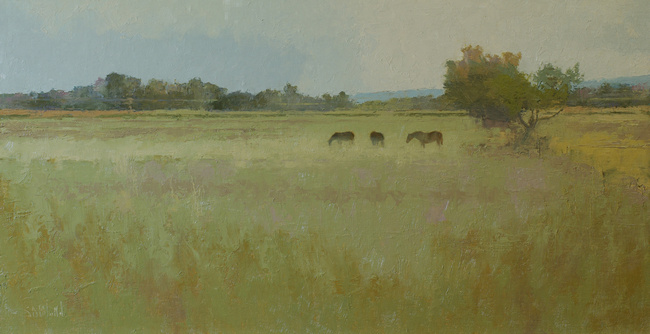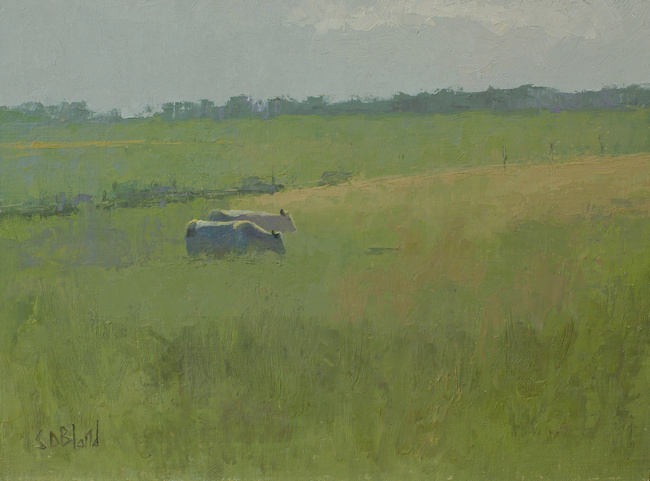Painting Animals in the Landscape
Simon Bland: 30 Sep 2017
I have a thing for landscape paintings with animals in them. Sometimes they are a great way to bring an image to life, make a statement or convey a feeling that would otherwise not be possible.
In my painting career I've treated animals and landscapes as separate things, rarely combining the two unless a portrait required a realistic setting. I was determined to change that—I spent a summer working on a series of paintings with farm animals in them. In this blog post I talk about the questions I asked myself while painting and the answers that I found.
If you want to try this for yourself, the most important thing you need is a full selection of reference photos of animals. It is even better if you already have some studies in a sketch book. Bear in mind that you are unlikely ever to capture all the animals you need for a painting in a single photograph. On most occasions, you will use several reference photos at a time.
Each of these paintings was done from a mix of photographs and plein air studies, and none were based on a single reference (that goes for the landscape setting as well as the animals).
Where should you place the animals?

North Bluff Horses. 6x12, oil on linen mounted on panel. 2016-18
The moment that you add any kind of figure to a landscape it will become one of the principal elements in the picture plane, if not the primary center of interest. That means it's important to place any figures (animal or otherwise) with care and to pay attention to the way in which they change the overall structure.
What I wanted to convey in this painting (in fact, it's also true of all the other paintings in this article) is that these horses are living their own, separate lives, disconnected from us.
I thought that statement was more effective with the horses placed in the middle-ground. They are distant enough to be done as simple figures, but still recognizable as horses. As I bring any of these horses into the foreground, they begin to lose their anonymity, and the picture becomes more portrait-like. If I push them too far back, they become much more difficult to identify and don't have nearly the same visual impact.
Do they fit with the landscape?

Corner of the Field. 8x10, oil on linen mounted on panel. 2015/17
I wanted to make sure that these sheep didn't look like they had been cut and pasted into the landscape (which is, in fact, exactly what happened).
I scumbled over the figures in the previous example to make them fit in better. Here I simply changed the color of the sheep to make them a closer match to the value and temperature of the dry grasses in the field. They look believable.
Do I have enough?

Cottonwoods. 11x14, oil on linen mounted on panel. 2017
I learned a couple of important lesson when painting sheep: A flock tends to scatter randomly over a large area and it's hard to find a center of interest; and there are often too many animals in a field to be able to include them all.
I learned that it was OK to leave out most of the animals and just include a few to create a focal point.
However, there are equally good artistic arguments to be made against this practice. Some artists use large groups of animals to create complex light and dark masses in the picture plane (see the work of Michael Workman for example), but I rarely come across scenes like that in real life.
What is the picture about?

Hale Farm. 12x24, oil on linen mounted on panel. 2017
I've already mentioned that the idea behind these paintings is that the animals have an existence that's separate from us. Each landscape also has an underlying theme and multiple layers of meaning.
In this case, I wanted the effect to be light on a hazy summer afternoon. The horses were included to add context, atmosphere, and a sense of scale.
It's also, for me, about other things. This is a field in our old hometown in Viginia which I painted not long after moving to Seattle. There's a bit of homesickness in it.
Are the animals easily recognizable?

Side by Side. 9x12, oil on linen. 2017
Horses and sheep in silhouette have distinct shapes that are easy to recognize. For that reason, it's straightforward to add them to paintings.
Cattle, on the other hand, are much harder to render. They lack the horse's graceful curves, the simple block shape of sheep, and they require careful painting to make them recognizable.
Bringing them further forward in the picture plane made the cows easier for a viewer to identify—I think this is a good idea whenever you paint cattle. However, that meant I couldn't use a single color and value to represent the parts in shadow—I had to paint them with four or five different grays plus the highlights.
Summing Up
Painting landscapes with animals in them can vary in difficulty depending on the complexity of the setting, the type and position of the animals, and the lighting.
Yet there's one thing that holds true for all these paintings: you must be able to paint an animal in silhouette without any visual aid except a photograph. The small scale of the figures and any existing paint layers make aids like grid lines useless. Like it did for me, it will take time and lots of practice to get it right.
This article was updated in April 2025
Simon Bland: 30 Sep 2017